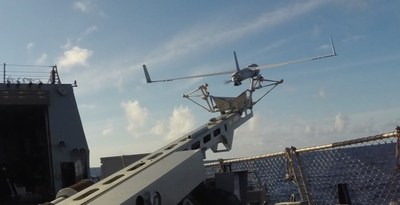
Ballard and Insitu have partnered over the past two years to integrate Ballard's prior generation fuel cell propulsion system – a complete hydrogen power system for small unmanned fixed wing and Vertical Take Off and Landing (VTOL) platforms – into the ScanEagle platform. Successful flight testing was announced in mid-2017.
The next generation fuel cell propulsion system announced today delivers a number of important advances: increased power density, resulting from a new membrane electrode assembly (MEA) design; reduced cost, resulting from a combination of new MEA and one-step fuel cell stack sealing process; and extended lifetime. The increase in rated power, without any appreciable increase in size or weight, is a particularly significant development for UAV applications.
Phil Robinson, Vice President of Unmanned Systems at Protonex, a Ballard subsidiary, said, "The Ballard and Insitu teams have collaborated closely over the past several years to integrate our proven fuel cell technology into the industry-leading ScanEagle platform. This new fuel cell has the potential to deliver a range of benefits compared to the use of an internal combustion engine, or ICE, to power the ScanEagle. These benefits are likely to include an increase in reliability and available electrical power along with a simultaneous reduction in audible noise, thereby enabling lower altitude missions."
Fuel cell propulsion systems offer a number of advantages over ICE-powered drones (refer to accompanying chart). In addition, fuel cells offer a 3x increase in mission time compared to battery-powered drones.
|
|
|
|
|
UAV ATTRIBUTES |
FUEL CELL |
ICE^ |
|
Low Mean Time Between
|
+ |
- |
|
Payload flexibility |
+ |
- |
|
Altitude flexibility |
+ |
- |
|
Load following flexibility |
+ |
- |
|
Low noise |
+ |
- |
|
Low vibration |
+ |
- |
|
Low thermal signature |
+ |
- |
|
Low environmental
|
+ |
- |
|
Endurance |
+ |
+ |
|
Fuel efficiency |
+ |
- |
|
^ ICE – internal combustion engine | ||
Andrew Duggan, Vice President and General Manager of Insitu Commercial added, "Insitu is pleased to continue our partnership with Ballard as we add capabilities, further increasing reliability and decreasing operating cost of the ScanEagle platform. We look forward to further performance tests and customer demonstrations in the coming year."
Insitu's ScanEagle is a versatile platform with multiple payload capabilities, including high-definition imaging, at a fraction of the cost of larger UAV systems. Insitu's platforms have logged more than one million flight hours in military and civilian applications, making ScanEagle the most proven UAV in its class. The ScanEagle is operated in conjunction with Insitu's Mark4 Launcher® – a low-maintenance, runway-independent platform – along with its SkyHook® recovery system.
ScanEagle is 1.55 meters (5.1 feet) in length, has a wingspan of 3.11 meters (10.2 feet) and maximum takeoff weight of 22 kilograms (48.5 lbs). The UAV can fly at a maximum speed of 41.2 meters per second (80 knots), reach a ceiling of 5,944 meters (19,500 feet). Additional details and images are available at http://www.insitu.com/information-delivery/unmanned-systems/scaneagle.
In addition to military use, the commercial market for drones is expected to growth significantly over the next few years, from 0.25 million working drones in 2017 to more than 2.5 million working drones by 2021.[1] Applications are anticipated in such areas as agriculture, construction, environmental management, urban & rural surveying, mining, emergency response and law enforcement.
For additional information regarding Ballard's work in the UAV area please visit http://www.ballard.com/markets/uav.
About Ballard Power Systems
Ballard Power Systems (NASDAQ: BLDP; TSX: BLDP) provides clean energy products that reduce customer costs and risks, and helps customers solve difficult technical and business challenges in power and energy. To learn more about Ballard, please visit
www.ballard.com.
This release contains forward-looking statements concerning anticipated product performance, customer benefits and market demand for our products. These forward-looking statements reflect Ballard's current expectations as contemplated under section 27A of the Securities Act of 1933, as amended, and Section 21E of the Securities Exchange Act of 1934, as amended. Any such forward-looking statements are based on Ballard's assumptions relating to its financial forecasts and expectations regarding its product development efforts, manufacturing capacity, and market demand.
These statements involve risks and uncertainties that may cause Ballard's actual results to be materially different, including general economic and regulatory changes, detrimental reliance on third parties, successfully achieving our business plans and achieving and sustaining profitability. For a detailed discussion of these and other risk factors that could affect Ballard's future performance, please refer to Ballard's most recent Annual Information Form. Readers should not place undue reliance on Ballard's forward-looking statements and Ballard assumes no obligation to update or release any revisions to these forward looking statements, other than as required under applicable legislation.








